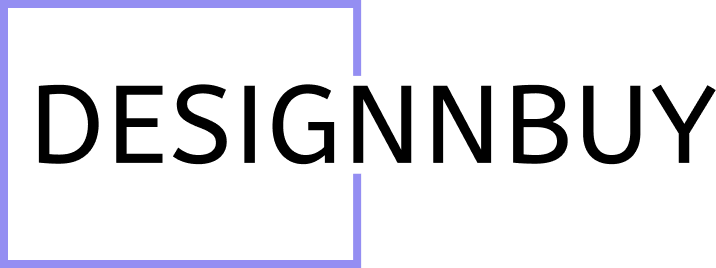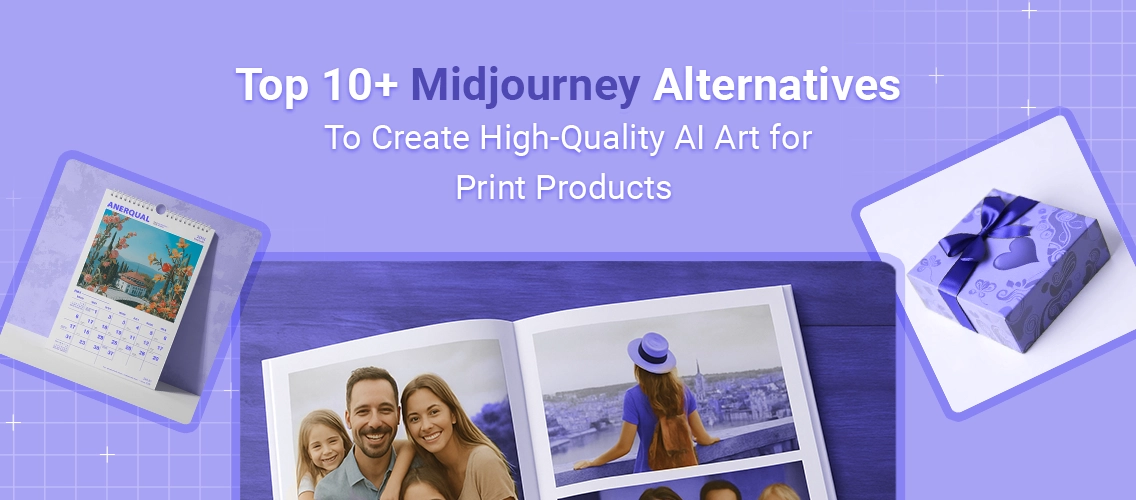The world of AI-generated art has tranformed how businesses approach creative content, especially in the print industry. While Midjourney has gained significant popularity as an AI art generator, it’s not the only player in the game.
Whether you’re looking for more control, better pricing, or specific features for print production, there are numerous powerful alternatives that can help you create stunning artwork for your print products.
Table of Contents
Top 10+ Midjourney Alternatives for High-Quality AI Art for Print Products
Since MidJourney became popular, a wide range of AI art tools have entered the market some offering photorealistic detail, while others focus on stylized artwork, patterns, or even branding concepts.
If you’re in the print or packaging industry, choosing the right tool depends on your specific needs whether you’re creating artwork for apparel, product packaging, posters, or other custom print products.
To help you stay ahead, we’ve curated 12 of the best MidJourney alternatives for generating high-quality, print-ready AI art that fits seamlessly into your design and production workflow.
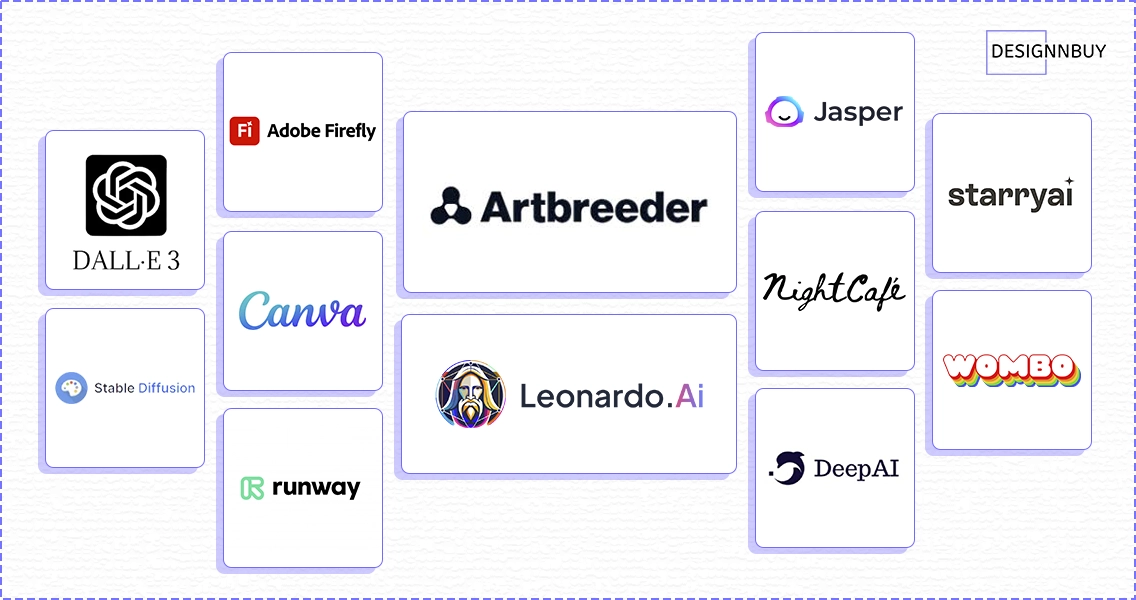
1. DALL-E 3 (OpenAI)
DALL-E 3 represents one of the most sophisticated AI art generators available today. Developed by OpenAI, it excels in creating highly detailed, photorealistic images that translate beautifully to print media.
Key Strengths for Print:
- Exceptional detail resolution suitable for large format printing
- Superior text integration capabilities for creating designs with readable text elements
- Consistent style maintenance across multiple generations
- Strong adherence to complex prompts with multiple elements
Best Use Cases: Marketing materials, book covers, magazine illustrations, and any print product requiring photorealistic imagery with text elements.
2. Stable Diffusion
Stable Diffusion stands out as an open-source alternative that offers unprecedented flexibility and customization options. This makes it particularly valuable for print businesses that need specific control over their output.
Key Strengths for Print:
- Open-source nature allows for custom modifications and fine-tuning
- High-resolution output capabilities with various upscaling options
- Extensive community-developed models for specific artistic styles
- No usage restrictions or monthly limits
- Can be run locally for complete control and privacy
Best Use Cases: Custom artwork for apparel printing, personalized products, and any application requiring specific style consistency or privacy considerations.
3. Adobe Firefly
Adobe Firefly integrates seamlessly into the Adobe Creative ecosystem, making it an excellent choice for print businesses already using Adobe’s design tools.
Key Strengths for Print:
- Native integration with Photoshop, Illustrator, and other Adobe products
- Commercial-safe training data reduces legal concerns
- Vector generation capabilities ideal for logo and graphic design
- Advanced editing and refinement tools within familiar Adobe interface
Best Use Cases: Professional graphic design for branding materials, logos, and any print project that benefits from vector graphics.
4. Canva AI
While known primarily as a design platform, Canva’s AI capabilities have evolved to become a powerful tool for print design, especially for businesses without extensive design experience.
Key Strengths for Print:
- User-friendly interface requires minimal learning curve
- Extensive template library specifically designed for print products
- Built-in print specifications and guidelines
- Direct integration with print services
- Team collaboration features for businesses with multiple users
Best Use Cases: Small business marketing materials, social media graphics for print campaigns, and standardized print templates.
5. Leonardo AI
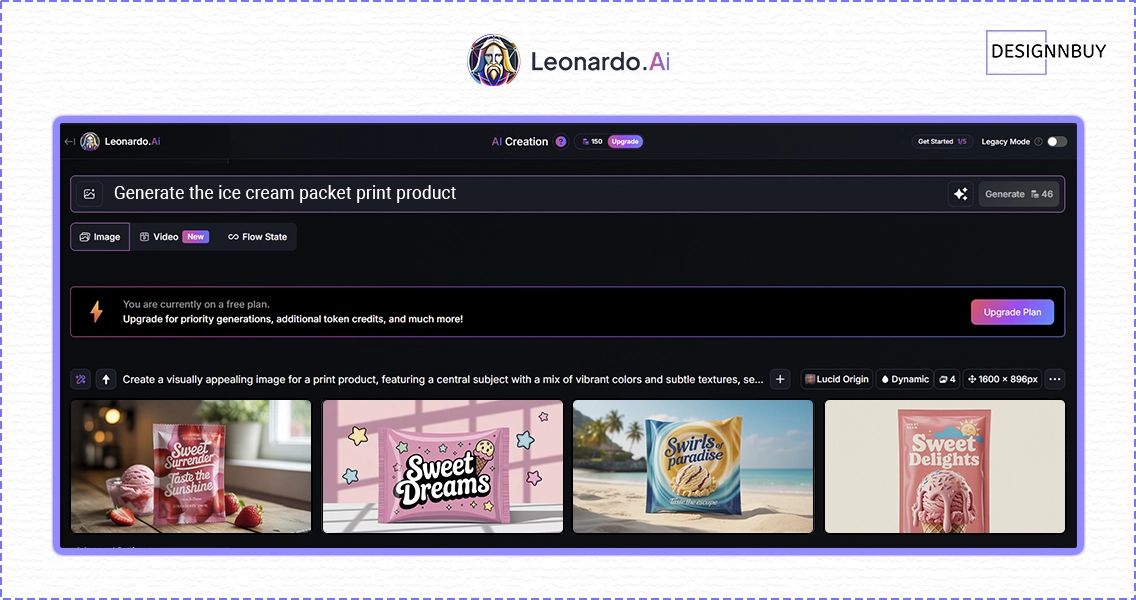
Leonardo AI has gained recognition for its focus on creative control and consistency, making it particularly suitable for businesses that need to maintain brand coherence across multiple print products.
Key Strengths for Print:
- Advanced fine-tuning capabilities for brand-specific styles
- Consistent character and element generation across multiple images
- High-quality photorealistic and artistic style options
- Batch processing capabilities for efficient workflow
- Community-shared models for specific artistic styles
Best Use Cases: Character design for children’s books, consistent branding elements across product lines, and artistic prints requiring style consistency.
6. Runway ML
Runway ML offers a comprehensive creative suite that extends beyond static image generation to include video and animation capabilities, making it valuable for multimedia print campaigns.
Key Strengths for Print:
- Multi-modal capabilities including image, video, and animation
- Professional-grade output quality
- Advanced editing and post-processing tools
- Collaboration features for creative teams
- API access for integration into existing workflows
Best Use Cases: Dynamic print campaigns that extend to digital media, animated elements for packaging design, and multimedia marketing materials.
7. Jasper Art
Jasper Art focuses specifically on marketing and business applications, making it particularly relevant for print businesses creating promotional and advertising materials.
Key Strengths for Print:
- Marketing-focused templates and styles
- Brand kit integration for consistent visual identity
- High-resolution output suitable for professional printing
- User-friendly interface designed for non-designers
- Integration with Jasper’s content creation platform
Best Use Cases: Marketing collateral, advertising materials, social media graphics for print campaigns, and brand-consistent promotional materials.
8. Artbreeder
Artbreeder takes a unique collaborative approach to AI art generation, allowing users to blend and evolve images through an intuitive interface.
Key Strengths for Print:
- Unique blending and evolution capabilities for creating original artwork
- High-resolution output options
- Community sharing and collaboration features
- Precise control over image characteristics
- Suitable for creating variations of existing designs
Best Use Cases: Custom artwork evolution, creating variations for A/B testing print designs, and collaborative art projects.
9. NightCafe Creator
NightCafe Creator offers a comprehensive AI art platform with multiple algorithms and styles, providing flexibility for diverse print applications.
Key Strengths for Print:
- Multiple AI algorithms including Stable Diffusion, DALL-E, and others
- Extensive style options from photorealistic to abstract art
- Community features for inspiration and collaboration
- Batch creation capabilities
- Print-on-demand integration options
Best Use Cases: Artistic prints, diverse style exploration for brand development, and community-driven design inspiration.
10. DeepAI
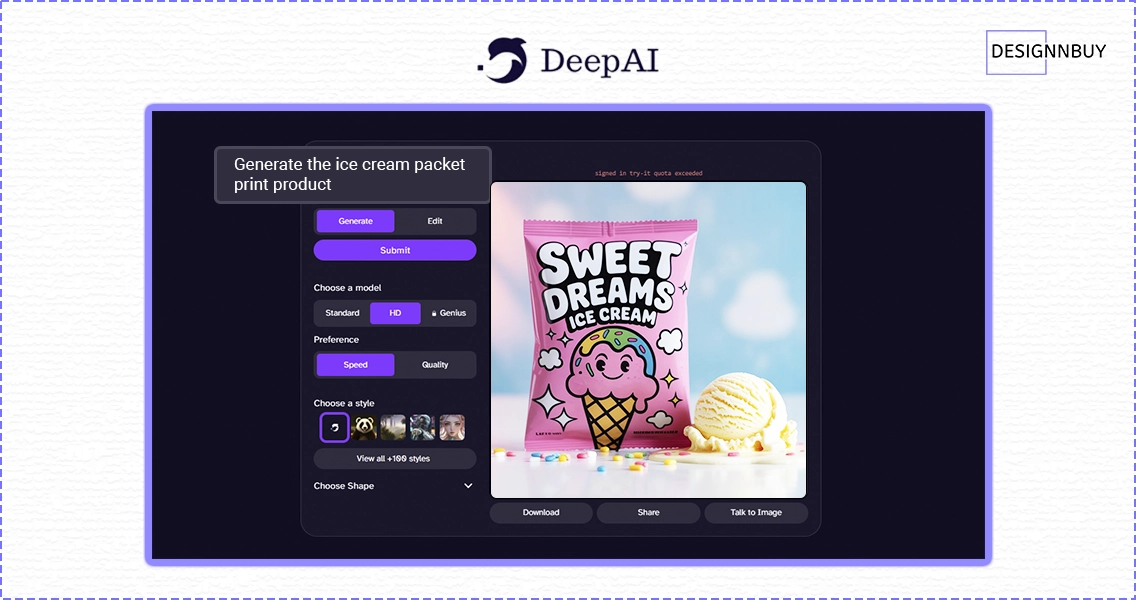
DeepAI provides a straightforward, API-focused approach to AI art generation, making it suitable for businesses that want to integrate AI art generation directly into their existing systems.
Key Strengths for Print:
- Simple API integration for custom applications
- Multiple style options and customization parameters
- Reliable uptime and performance for business applications
- Transparent pricing structure
- Minimal learning curve for implementation
Best Use Cases: Custom web-to-print applications, automated design generation for large product catalogs, and integration into existing business systems.
11. Starry AI
Starry AI offers a mobile-first approach to AI art generation while still providing high-quality outputs suitable for print applications.
Key Strengths for Print:
- Mobile-optimized interface for on-the-go creation
- High-quality artistic styles particularly strong in abstract and artistic designs
- User ownership of generated images
- Regular style updates and improvements
- Batch processing capabilities
Best Use Cases: Artistic print designs, mobile workflow integration, and creative exploration for print concepts.
12. Dream by WOMBO
Dream by WOMBO provides an accessible entry point into AI art generation with a focus on artistic and creative outputs.
Key Strengths for Print:
- Extremely user-friendly interface
- Strong artistic and abstract style capabilities
- Fast generation times
- Mobile and web accessibility
- Community sharing features
Best Use Cases: Artistic prints, creative exploration, and quick concept generation for print ideas.
Key Features to Look for in AI Art Generators for Print
When evaluating AI art generators for print applications, certain features are more critical than others. Understanding these key capabilities will help you make an informed decision that aligns with your business needs.
High Resolution Output: Print products require high-resolution images to ensure crisp, professional results. Look for generators that can produce images at 300 DPI or higher, with dimensions suitable for your target print sizes.
Style Consistency: For brand coherence across multiple print products, you need a tool that can maintain consistent artistic styles and themes across different generated images.
Commercial License Clarity: The legal terms surrounding commercial use of AI-generated art can be complex. Choose platforms that provide clear commercial licensing terms to avoid potential legal complications.
Customization Controls: Advanced prompt engineering capabilities, style parameters, and fine-tuning options allow for more precise control over the final output, which is essential for meeting specific client requirements.
Batch Processing: For high-volume print operations, the ability to generate multiple variations or process multiple prompts simultaneously can significantly improve workflow efficiency.
Final Thoughts
The world of AI art generation is opening new doors for print businesses, with many alternatives to Midjourney offering unique strengths. Whether it’s the photorealistic output of DALL·E 3 or the open-source flexibility of Stable Diffusion, the “best” tool really depends on your business needs, technical comfort, and budget.
But here’s the thing, success with AI art in printing isn’t about picking a tool and running with it. It’s about knowing what these tools can and can’t do. They’re fantastic for fast ideation, maintaining a consistent design style, and scaling creative output but they shine brightest when paired with human judgment for quality control and brand alignment.
As AI evolves, print-focused features will only get smarter and more powerful. Businesses that experiment now will be better prepared to leverage these advancements and stay ahead of the curve. The smartest approach? Start small, test thoroughly, and integrate AI art step by step so it complements rather than complicates your existing workflows.
At DesignNBuy, we’ve already started bringing AI into our web-to-print solutions helping printers explore new creative possibilities while keeping production efficient and customer-focused. By combining the power of AI with the reliability of our design and ordering workflows, we’re making it easier for print providers to turn fresh ideas into profitable outcomes.
With the right strategy and the right partner, you can expand your creative capabilities, improve efficiency, and grow profitability in ways that truly future-proof your print business.
Bring AI to Your Print Business
Get expert help to choose and implement the right AI tools
We hope you liked exploring these tools that you can use for your online print store!
Did you enjoy this article? Explore more related posts before you go:
- Top 9 AI Tools for Web-To-Print Shops in 2025
- Top AI Models and Tools for Print Service Providers and Packaging Businesses in 2025
- 5 Game-Changing AI Automations for Print and Packaging Businesses in 2025
- 18 Awesome ChatGPT Prompts for Web-To-Print Shops in 2025
- Nano Banana AI: The Future of Printing & Packaging Industry
